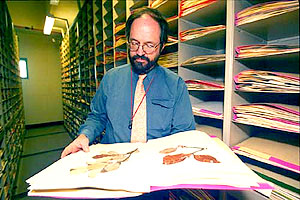 |
QUICK SEARCH
MO PROJECTS:
Africa
Asia/Pacific
Mesoamerica
North America
South America
General Taxonomy
Photo Essays
Training in Latin
America
MO RESEARCH:
Wm. L. Brown Center
Bryology
GIS
Graduate Studies
Research Experiences
for Undergraduates
Imaging Lab
Library
MBG Press
Publications
Climate Change
Catalog Fossil Plants
MO DATABASES:
W³MOST
Image Index
Rare Books
Angiosperm
Phylogeny
Res Botanica
All Databases
INFORMATION:
What's New?
People at MO
Visitor's Guide
Herbarium
Jobs & Fellowships
Symposium
Research Links
Site Map
Search
 | table of contents |
Creating an accessible, open-ended library of urgently needed information. | |
| Systematics produces two major types of botanical studies: monographic treatments and floristic inventories. Written treatments of plant groups are based on studies of living plants, dried herbarium specimens, and botanical literature. By organizing vast amounts of botanical information, both monographs and floras add to our understanding of the characteristics, relationships, and geographical distribution of plants. The studies also highlight gaps in the knowledge base, helping scientists to focus their research efforts.
Monographic research refers to the study of particular groups of plants, regardless of where they grow, and revision of their scientific classification if necessary. Almost every botanist at the Garden specializes in one or more plant families. Floristic research involves the massive job of producing a complete descriptive record of all plant species found in a particular geographic region, based on extensive exploration and collecting. The most ambitious floras document the plants of large areas, continents, or regions of high diversity. It can take decades to complete a major flora. To speed the dissemination of information, investigators may first produce a checklist - a bare-bones inventory of a region's plants. Unlike a flora, it contains no descriptions or illustrations of plants, but is limited to names, bibliographic references, abbreviated geographical distributions, and other associated data. As floristic studies proceed, all information is entered into TROPICOS, the Garden's botanical database, where it is constantly updated and available online. This creates, in effect, an open-ended library of urgently needed information that is immediately accessible to users worldwide. | |
 | Curator Peter C. Hoch studies Onagraceae, the evening primrose family, including phylogenetic and biogeographical studies, with particular emphasis on Epilobium, the fireweed genus. |
Next Section >> | |
| Text and photos from "The Unseen Garden" available from MBG Press. | |
© 1995-2025 Missouri Botanical Garden, All Rights Reserved
4344 Shaw Blvd.
St. Louis, MO 63110
(314) 577-5100
Technical Support